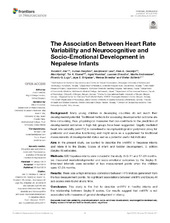| dc.contributor.author | Ask, Torvald F. | |
| dc.contributor.author | Ranjitkar, Suman | |
| dc.contributor.author | Manjeswori, Ulak | |
| dc.contributor.author | Chandyo, Ram Krishna | |
| dc.contributor.author | Hysing, Mari | |
| dc.contributor.author | Strand, Tor A | |
| dc.contributor.author | Kvestad, Ingrid | |
| dc.contributor.author | Shrestha, Laxman | |
| dc.contributor.author | Andreassen, Marita | |
| dc.contributor.author | Lugo, Ricardo Gregorio | |
| dc.contributor.author | Shilpakar, LB | |
| dc.contributor.author | Shrestha, Marina | |
| dc.contributor.author | Sütterlin, Stefan | |
| dc.date.accessioned | 2019-08-20T13:54:27Z | |
| dc.date.available | 2019-08-20T13:54:27Z | |
| dc.date.issued | 2019-04-26 | |
| dc.Published | Ask TF, Ranjitkar S, Manjeswori U, Chandyo RK, Hysing M, Strand TA, Kvestad I, Shrestha L, Andreassen M, Lugo RG, Shilpakar L, Shrestha, Sütterlin S. The Association Between Heart Rate Variability and Neurocognitive and Socio-Emotional Development in Nepalese Infants . Frontiers in Neuroscience. 2019;13(411) | eng |
| dc.identifier.issn | 1662-453X | |
| dc.identifier.issn | 1662-4548 | |
| dc.identifier.uri | https://hdl.handle.net/1956/20693 | |
| dc.description.abstract | Background: Many young children in developing countries do not reach their developmental potential. Traditional methods for assessing developmental outcome are time consuming, thus, physiological measures that can contribute to the prediction of developmental outcomes in high risk groups have been suggested. Vagally mediated heart rate variability (vmHRV) is considered a neurophysiological or peripheral proxy for prefrontal and executive functioning and might serve as a supplement for traditional measurements of developmental status and as a potential useful risk indicator. Aim: In the present study, we wanted to describe the vmHRV in Nepalese infants and relate it to the Bayley Scales of infant and toddler development, 3. edition (Bayley-III) subscales. Methods: 600 Nepalese infants were included in the study. At 6–11 and 17–24 months, we measured neurodevelopmental and socio-emotional outcomes by the Bayley-III. Inter-beat intervals were recorded at two measurement points when the children were 17–24 months. Results: There was a high intraclass correlation between HRV indices generated from the two measurement points. No significant associations between vmHRV and Bayley-III sub scales were found at any time. Conclusion: This study is the first to describe vmHRV in healthy infants and the relationship between Bayley-III scores. Our results suggest that vmHRV is not associated with measures of general development in infancy. | en_US |
| dc.language.iso | eng | eng |
| dc.publisher | Frontiers | eng |
| dc.rights | Attribution CC BY | eng |
| dc.rights.uri | http://creativecommons.org/licenses/by/4.0/ | eng |
| dc.subject | heart rate variability | eng |
| dc.subject | neurodevelopment | eng |
| dc.subject | socio-emotional development | eng |
| dc.subject | neurocognitive development | eng |
| dc.subject | Bayley scales of infant and toddler development | eng |
| dc.subject | vagal tone | eng |
| dc.title | The Association Between Heart Rate Variability and Neurocognitive and Socio-Emotional Development in Nepalese Infants | eng |
| dc.type | Peer reviewed | |
| dc.type | Journal article | |
| dc.date.updated | 2019-05-24T12:25:49Z | |
| dc.description.version | publishedVersion | |
| dc.rights.holder | Copyright Ask 2019 | eng |
| dc.identifier.doi | https://doi.org/10.3389/fnins.2019.00411 | |
| dc.identifier.cristin | 1691377 | |
| dc.source.journal | Frontiers in Neuroscience | |

